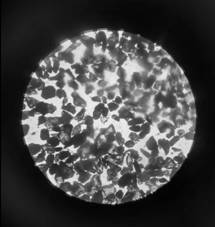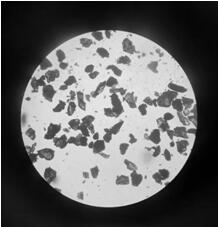A method of increasing the crystallization density of the perovskite absorber layer of solar cells
A technology of solar cells and crystal density, applied in circuits, electrical components, photovoltaic power generation, etc., can solve problems such as poly-grain boundary voids, and achieve the effect of reducing voids, improving effective transfer, and compact and dense grain arrangement
- Summary
- Abstract
- Description
- Claims
- Application Information
AI Technical Summary
Problems solved by technology
Method used
Image
Examples
Embodiment 1
[0038] Step 1: Mix polypropylene resin and acrylic acid grafted polypropylene according to the weight ratio of 100 parts by weight: 15 parts by weight, melt and plasticize the uniformly mixed mixture through an extrusion system, and cast to form a 0.6mm thick base film, After heat treatment, the base film is heated to 110°C and stretched, and the stretched base film is stretched 3 times in the longitudinal direction; the cooling rate is 25°C / min to obtain a heat-shrinkable film, and the heat-shrinkable film is laid flat On the surface of alumina ceramic substrate;
[0039] Step 2: Dissolve 10 parts by weight of methylamine iodine and 30 parts by weight of lead iodide in 100 parts by weight of DMF solvent to prepare a perovskite precursor solution, spin the precursor at a rotation rate of 1000r / min, and spin coating for 30s On the heat-shrinkable film; after drying at 40°C, use a mold to compact the formed film and keep the pressure at 5.5MPa;
[0040] Step 3: After annealing ...
Embodiment 2
[0043] Step 1: Mix polypropylene resin and acrylic acid grafted polypropylene according to the weight ratio of 100 parts by weight: 15 parts by weight, melt and plasticize the uniformly mixed mixture through an extrusion system, and cast to form a 0.6mm thick base film, After heat treatment, the base film is heated to 120°C and stretched, and the stretched base film is stretched 4 times in the longitudinal direction; the cooling rate is 15°C / min to obtain a heat-shrinkable film, and the heat-shrinkable film is laid flat On the surface of alumina ceramic substrate;
[0044] Step 2: Dissolve 10 parts by weight of methylamine iodine and 30 parts by weight of lead iodide in 100 parts by weight of DMF solvent to prepare a perovskite precursor solution, spin the precursor at a rotation rate of 1500r / min, and spin coating for 30s On the heat-shrinkable film; after drying at 45°C, use a mold to compact the formed film and keep the pressure at 6MPa;
[0045] Step 3: After annealing th...
Embodiment 3
[0048] Step 1: Mix polypropylene resin and acrylic acid grafted polypropylene according to the weight ratio of 100 parts by weight: 15 parts by weight, melt and plasticize the uniformly mixed mixture through an extrusion system, and cast to form a 0.6mm thick base film, After heat treatment, the base film is heated to 130°C and stretched, and the stretched base film is stretched 5 times in the longitudinal direction; the cooling rate is 35°C / min to obtain a heat-shrinkable film, and the heat-shrinkable film is laid flat On the surface of alumina ceramic substrate;
[0049] Step 2: Dissolve 10 parts by weight of methylamine iodine and 30 parts by weight of lead iodide in 100 parts by weight of DMF solvent to prepare a perovskite precursor solution, spin the precursor at a rotation rate of 3000r / min, and spin coating for 30s On the heat-shrinkable film; after drying at 60°C, use a mold to compact the formed film and keep the pressure at 5.5MPa;
[0050] Step 3: After annealing ...
PUM
| Property | Measurement | Unit |
|---|---|---|
| thickness | aaaaa | aaaaa |
Abstract
Description
Claims
Application Information
 Login to View More
Login to View More - R&D
- Intellectual Property
- Life Sciences
- Materials
- Tech Scout
- Unparalleled Data Quality
- Higher Quality Content
- 60% Fewer Hallucinations
Browse by: Latest US Patents, China's latest patents, Technical Efficacy Thesaurus, Application Domain, Technology Topic, Popular Technical Reports.
© 2025 PatSnap. All rights reserved.Legal|Privacy policy|Modern Slavery Act Transparency Statement|Sitemap|About US| Contact US: help@patsnap.com


